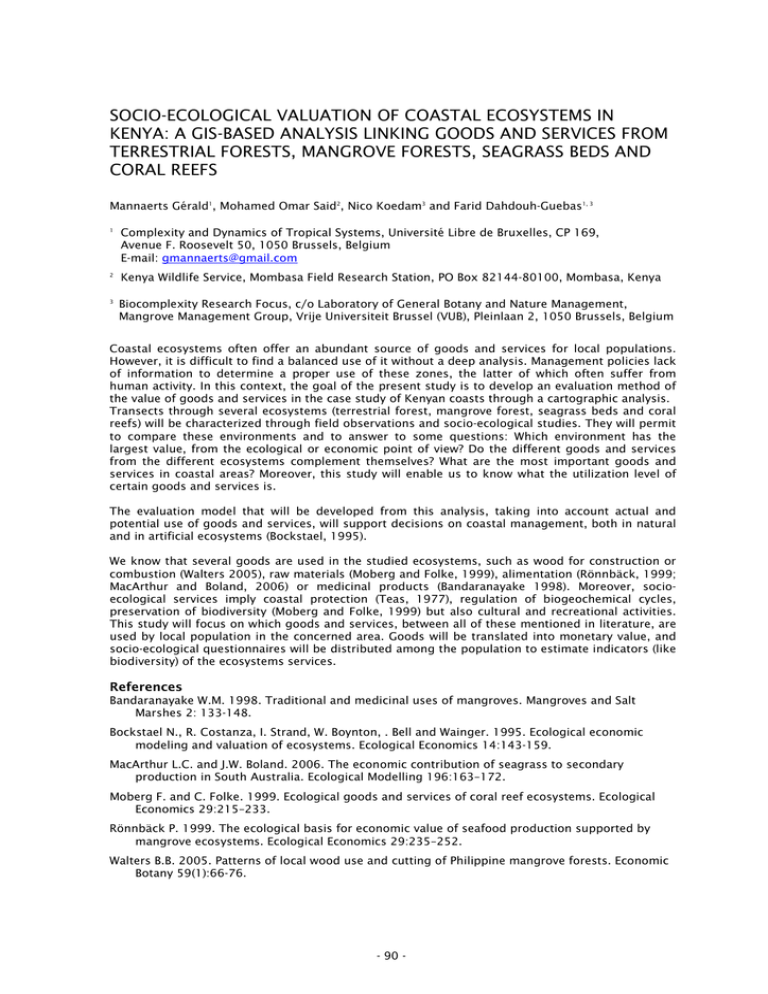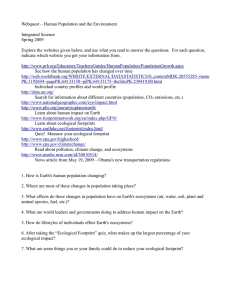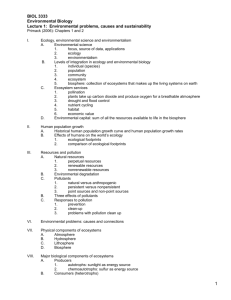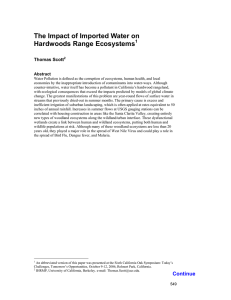SOCIO-ECOLOGICAL VALUATION OF COASTAL ECOSYSTEMS IN
advertisement

SOCIO-ECOLOGICAL VALUATION OF COASTAL ECOSYSTEMS IN KENYA: A GIS-BASED ANALYSIS LINKING GOODS AND SERVICES FROM TERRESTRIAL FORESTS, MANGROVE FORESTS, SEAGRASS BEDS AND CORAL REEFS Mannaerts Gérald1, Mohamed Omar Said2, Nico Koedam3 and Farid Dahdouh-Guebas1, 3 1 Complexity and Dynamics of Tropical Systems, Université Libre de Bruxelles, CP 169, Avenue F. Roosevelt 50, 1050 Brussels, Belgium E-mail: gmannaerts@gmail.com 2 Kenya Wildlife Service, Mombasa Field Research Station, PO Box 82144-80100, Mombasa, Kenya 3 Biocomplexity Research Focus, c/o Laboratory of General Botany and Nature Management, Mangrove Management Group, Vrije Universiteit Brussel (VUB), Pleinlaan 2, 1050 Brussels, Belgium Coastal ecosystems often offer an abundant source of goods and services for local populations. However, it is difficult to find a balanced use of it without a deep analysis. Management policies lack of information to determine a proper use of these zones, the latter of which often suffer from human activity. In this context, the goal of the present study is to develop an evaluation method of the value of goods and services in the case study of Kenyan coasts through a cartographic analysis. Transects through several ecosystems (terrestrial forest, mangrove forest, seagrass beds and coral reefs) will be characterized through field observations and socio-ecological studies. They will permit to compare these environments and to answer to some questions: Which environment has the largest value, from the ecological or economic point of view? Do the different goods and services from the different ecosystems complement themselves? What are the most important goods and services in coastal areas? Moreover, this study will enable us to know what the utilization level of certain goods and services is. The evaluation model that will be developed from this analysis, taking into account actual and potential use of goods and services, will support decisions on coastal management, both in natural and in artificial ecosystems (Bockstael, 1995). We know that several goods are used in the studied ecosystems, such as wood for construction or combustion (Walters 2005), raw materials (Moberg and Folke, 1999), alimentation (Rönnbäck, 1999; MacArthur and Boland, 2006) or medicinal products (Bandaranayake 1998). Moreover, socioecological services imply coastal protection (Teas, 1977), regulation of biogeochemical cycles, preservation of biodiversity (Moberg and Folke, 1999) but also cultural and recreational activities. This study will focus on which goods and services, between all of these mentioned in literature, are used by local population in the concerned area. Goods will be translated into monetary value, and socio-ecological questionnaires will be distributed among the population to estimate indicators (like biodiversity) of the ecosystems services. References Bandaranayake W.M. 1998. Traditional and medicinal uses of mangroves. Mangroves and Salt Marshes 2: 133-148. Bockstael N., R. Costanza, I. Strand, W. Boynton, . Bell and Wainger. 1995. Ecological economic modeling and valuation of ecosystems. Ecological Economics 14:143-159. MacArthur L.C. and J.W. Boland. 2006. The economic contribution of seagrass to secondary production in South Australia. Ecological Modelling 196:163–172. Moberg F. and C. Folke. 1999. Ecological goods and services of coral reef ecosystems. Ecological Economics 29:215–233. Rönnbäck P. 1999. The ecological basis for economic value of seafood production supported by mangrove ecosystems. Ecological Economics 29:235–252. Walters B.B. 2005. Patterns of local wood use and cutting of Philippine mangrove forests. Economic Botany 59(1):66-76. - 90 -








